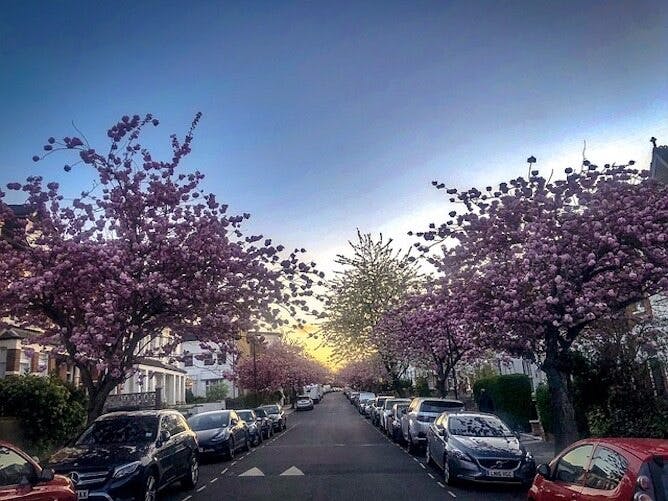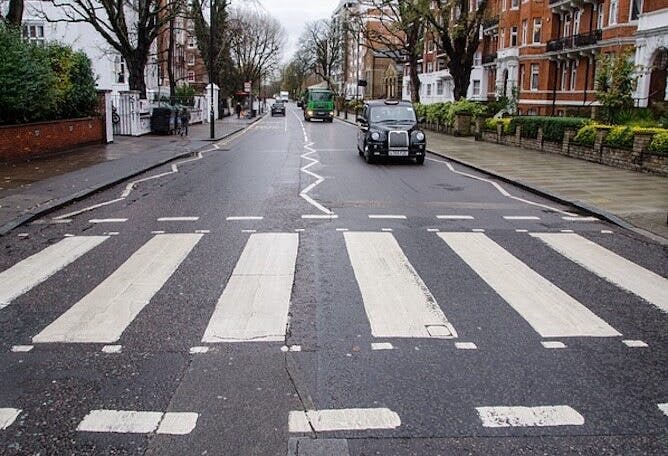
Parking rules can be confusing, even for experienced drivers. But they’re really important to get your head around—not so that you can correctly demonstrate your parking skills on the driving test, but also because you’ll bear responsibility for anywhere you leave a vehicle... for the rest of your life. Dramatic! Stopping in the wrong place can make things dangerous for other road users, so councils and the police disincentivise this by issuing fines Penalty Charge Notices (PCNs) and Fixed Penalty Notices (FPNs).
To really get to grips with where you are and aren’t allowed to park, you need to understand the role and wording of the Highway Code. It’s not a legal document, so it mostly offers advice and best practice rules for drivers. However, anywhere that says ‘MUST’ or ‘MUST NOT’ means the rule is backed up by UK law.
But there are more things to consider than just legality when deciding where to pull up in your car. Let's take a good look at the UK's on-street parking rules.
General parking rules

As a good starting point, Rule 239 of the Highway Code sets out a number of key parking rules. These tend to align with common sense—such as ensuring your handbrake is on before exiting the vehicle. They also include the legal obligations to switch off your engine, headlights and foglights when parked (which reduces emissions and prevents confusion or dazzle for other drivers) and avoid hitting other road users when you open your door, ideally making use of the Dutch Reach method.
The Highway Code also encourages drivers to:
- Tuck in nice and close to the kerb (if you're struggling with this one, we have a handy guide to parallel parking that will help)
- Give vehicles displaying a Blue Badge plenty of room
- Park with the traffic flow, i.e., in the same direction as the traffic is driving on that side of the road.
This last point might seem at odds with the practical test manoeuvre to pull up on the right, but that’s because it’s not illegal to park the other way around, and there are times when you’re likely to have to do so.
On-street parking
In an ideal world, there would be enough designated parking spaces for the amount of traffic that requires them. These are areas marked out into bays, or along roadsides with broken white lines. You usually have to pay for the privilege of parking, using either an app or a traditional parking metre, display your ticket clearly, and make sure you don’t overstay your welcome. But there are plenty of other scenarios, particularly on residential roads, where the on-street parking rules are a little more stringent.
Look out for signs—and information on local authority websites—indicating different zones, such as Controlled Parking Zones or Restricted Parking Zones. Even where a lack of road markings suggest otherwise, there are rules in place to limit where and when people can park there.
Permit holder only areas
Some streets boast parking, but for those who have a resident's permit, or a temporary visitors permit only. These rules might be in force 24 hours a day, or there may be times when the general public can pay to park there. Check signs on the street (they tend to be small, white and rectangular) to establish whether you’re allowed to pull up or not.
Bottom line: Only park in a permit parking area if you have a valid permit.
Can you park on a dropped kerb?

Dropped kerbs are areas where the kerb has been lowered. This is to improve access for:
- Pedestrians — particularly those with limited sight, using wheelchairs or mobility scooters, or pushing prams or pushchairs, or
- Vehicles — such as for those entering or exiting a driveway.
Rule 243 of the Highway Code says:
‘DO NOT stop or park…where the kerb has been lowered to help wheelchair users and powered mobility vehicles’.
Many councils will only enforce ‘unfriendly parking’, which means they won’t usually fine people who have been given permission by the residents in the house outside which you’re parked, or if you are parked on a dropped kerb outside your own house.
However, if you don't have permission, you’re looking at causing some serious inconvenience and can get a PCN from the council.
Bottom line: Don’t park on a dropped kerb.
Can you park opposite a dropped kerb?
There’s no legal requirement to avoid parking opposite a dropped kerb, so long as you aren't breaking any other parking restrictions. But you should always consider how wide the road is, and whether people can get their vehicles in and out of their driveways easily. You don’t want to get scraped if you can help it!
Bottom line: You may park opposite a dropped kerb where it’s sensible and safe to do so.
Can you park in front of a driveway?

Blocking someone’s driveway is a surefire way to ruffle feathers. Drives will usually have a dropped kerb enabling vehicles to access them, so that’s an automatic no-go zone, and can result in a penalty charge from the council.
But even if a driveway doesn’t have a dropped kerb, you should still avoid blocking it. Residents or their visitors may have mobility limitations or young children; it’s often not a simple case of ‘they can just park elsewhere’. The police may get involved if you block a vehicle from getting out, under antisocial behaviour laws.
Bottom line: Don’t block someone’s driveway unless you’ve got permission from the occupiers.
Can you park on someone else's drive?
Unless you’re visiting the people who live there, or have some special arrangement with the occupants, most of us would never dream of parking on someone else’s drive. But in case you’re ever tempted to do so, remember that you’ll most likely be committing the civil offence of trespassing on private property.
In reality, the residents may have a hard time getting you forced off the driveway. It’s not a crime (civil matters are enforced in different types of courts), so the police probably won’t get involved. And if you’re insured and taxed, you won’t count as an ‘abandoned vehicle’, so the council might steer clear too. But technically you could get sued—and at the very least you’ll probably be on the receiving end of a telling off.
Bottom line: Unless you have permission, don’t park on someone else’s drive.
Can you park on zig-zag lines?

Zig-zag lines usually indicate the approach to, or exit from, pedestrian crossings. You’ll also find them as part of ‘School Keep Clear’ road markings, outside hospitals, police and fire stations. It’s against the law to park on zig-zagged lines, because your vehicle would obstruct pedestrians’ (and other drivers’) vision.
Yellow zig-zags should be accompanied by signs reminding you of the no-parking rules. White zig-zag markings don’t need any signs to make them enforceable. Park on them at your peril (or, at least, at the risk of a fine).
Bottom line: It’s usually illegal to park on zig-zag road markings.
Can you park on a single white line?
It’s usually okay to park on single white lines, except if there’s no pavement, in which case parking isn’t allowed. You should also make sure you’re not breaking any other UK parking laws, and take a look at how your vehicle would affect other road users.
Bottom line: Parking on single white lines is usually allowed.
Can you park on yellow or red lines?
Parking on yellow lines
You aren’t allowed to park on single yellow lines unless you’re outside of the days or times shown on the corresponding sign. Check it carefully to avoid incurring a penalty charge.

You’re almost never allowed to park on double yellows, even if you ‘just need to nip into that shop there’.
Bottom line: You may sometimes park on single yellows, but not on double yellow lines.
Are you allowed to park on red routes?
In some areas, red lines are used instead of yellow lines to indicate a red route — a particularly busy road where parking is generally prohibited. Where you see a single red line, check signs to see if and when you may park. Double red lines are code for ‘keep driving’.
Bottom line: Parking on single red lines may be permitted at certain times. Double red lines are no-parking zones.
There are some exceptions to yellow and red line rules for unloading or loading vehicles and for blue disabled badge holders. Check them out in more detail in our guide to single and double yellow lines.
Can you park on the pavement?

There are different rules about parking on the pavement depending where in the UK you are. Outside of London, the default is that parking on pavements is allowed. But there are plenty of exceptions to the rule, such as if you are causing an obstruction.
If your parking position forces pedestrians out onto the road, you may get a fine. Remember that some pedestrians, such as wheelchair users or those pushing prams, need more space than others.
In London (and Scotland from 2023), the law is the other way around. You’re generally not allowed to park on the pavement (even one wheel counts). Any exceptions will be clearly marked on signs.
Bottom line: Never park on a pavement in London or Scotland unless signs allow it. Elsewhere, check road signs and consider how hazardous your actions are.
Can you park near a junction?

The Highway Code recommends parking at least 10 metres away from a junction, except where there are legitimate parking bays available. Drivers pulling out will have a tough time checking for traffic from both directions if you’re blocking their view, increasing the chances of accidents.
You also need to consider pedestrians and larger vehicles. If you’re in the way, they may struggle to make the turn without mounting the pavement.
There’s no specific law prohibiting parking closer to a junction (rule 243 of the Highway Code says ‘DO NOT’, rather than ‘MUST NOT’). However, you could still incur a parking ticket if you’re deemed to be causing an unnecessary obstruction.
Bottom line: Where possible, avoid parking less than 10 metres away from a junction.
Can you park opposite a junction?
Parking opposite a junction can make things particularly dangerous for other road users. You’re essentially forcing drivers to move into the path of oncoming or emerging traffic, which may not have a clear view.
Bottom line: Try not to park opposite a junction.
Are you allowed to double park?

Double parking refers to parking on the opposite side of the street to another parked car. Depending on how narrow the road is, it can make it difficult for other drivers to get past the stationary vehicles—especially in two-way traffic.
It’s not an ideal scenario, so if you have the option, choose a better spot to pull up. Where you need to double park, though, always make sure a vehicle (even a wide one) can fit between the parked cars safely, and take extra care exiting your vehicle.
Bottom line: Parking opposite another parked car is inadvisable, but sometimes necessary.
The bottom, bottom line
Get to know where on-street parking is absolutely not allowed — like dropped kerbs or double yellow lines. For everywhere else, think about how much of an obstruction your parked car will cause. Choose the safest option available, and always always always be considerate to other road users, especially vulnerable pedestrians.
FAQs
How much will I have to pay if I get a PCN or FPN for illegal on-street parking?
The amount you may be charged for poor parking varies, depending on which local authority area you’re in, and how quickly you cough up the money (you usually get a 50% reduction for PCNs if you pay within 14 days). All told, you’re likely to be looking at between £50 and £120—although costs can increase if you refuse to pay or lose a challenge in court.
Can I challenge a parking ticket?
If you think you’ve been given a parking fine incorrectly, you can challenge it within 28 days. Do this as soon as possible — if you lose a PCN challenge but are still within 14 days of it being issued, you’ll only have to pay 50% of the fine.
It’s best to gather evidence at the scene if you can: a time stamped picture showing your parking position or proof that a parking meter wasn't working could help clear your name. There are more details about how to challenge the various types of fine on the government website.
Are there any extra rules for parking at night?
Many drivers aren’t aware of these rules, but it’s against the law to park against the flow of traffic on the street at night (unless you’re in an authorised parking space). You must also keep your parking lights, or sidelights, on if you’re pulled up on a road where the speed limit exceeds 30mph.
What about on-street parking rules when there’s a big event going on?
During events that attract a lot of out-of-towners, such as festivals or prestigious sporting events, there may be a change to local parking rules. Always check for signs and online before assuming that normal restrictions apply (your best bet is to look at websites for both the event and the local authority).
Subscribe for driving advice, offers & more
We'd love to let you know about our courses, news and offers via email. You may unsubscribe at any time.
Star Genie Limited trading as PassMeFast. Company number 10093359
Copyright © 2024 owned by Star Genie Limited
PassMeFast, Blue Tower, MediaCityUK, Salford, M50 2ST

